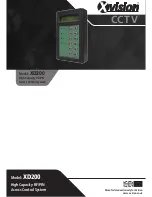
27
APPENDIX C - Common Questions and Situations
Q. During programming of a firing, I typed a wrong number. How do I correct
this?
A.
Before pressing ENTER, enter zero until all zeros are displayed, then enter the correct
number. If you have already pressed ENTER, you must press enter to progress
through to the end of the program then start the program again.
Q. How do I clear the “PF” from the display?
A. Press the “1” key. After several seconds the current temperature will be displayed.
Several other numbers or STOP may be displayed before the current temperature.
Q. What does it mean when “FAIL” is displayed?
A. Most likely the t/c (thermocouple) is defective. See P. 18 ("bd T", board temperature)
to determine if the t/c or circuit board is at fault. If the t/c is faulty, it may actually be
poor connections on any extension wire rather than the t/c itself. For type K
thermocouples check all connections and ensure that yellow wires are connected to
yellow wires and red to red all the way from the circuit board to the t/c in the kiln. It
is a good idea to loosen the screw connections and then retighten them to break any
oxide that may have built up. When connecting the thermocouple, connect the RED
wire to the connector with RED dot and connect the YELLOW wire to the connector
with the “+”. On type "K" thermocouples, the RED wire is always negative, and the
YELLOW wire is positive. On type “S” thermocouples the RED wire is negative and
the BLACK wire is positive.
Q. How can I find out the final temperature that was reached during a cone firing?
A. At the end of a cone fire, the firing time and CPLt will be flashing alternately in the
display. Press “STOP”. Then press “Review Program”, the final temperature will
display after oF. This final temperature will be retained until the next firing or until
the controller is reprogrammed or turned off.
Q. What is a segment?
A. A segment is the basic building block of a program either in cone-fire or vary-fire
(ramp/hold). Each segment consists of a ramp rate in degrees per hour, a temperature
you want to achieve, and whether you want to hold there or not. For example, a
program for drying ware going at 60
o
/hour to 200
o
F and holding for 2 hours would be
a one segment firing, the ramp is 60, the temperature is 200, and the hold is 2.00.
Q. Do I need to use witness cones for each firing?
A. After checking your kiln with witness cones for the first few firings, if you are
satisfied with the results you are getting and how even the kiln is from top to bottom
then you do not need to use cones in each firing. It is a good practice to periodically
place witness cones in the kiln to check for proper firing. If you suspect a problem or
your results have changed then it is a good idea to check the operation of the kiln with
witness cones.



































